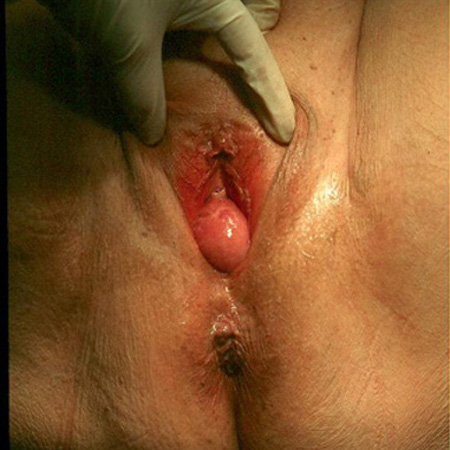History and exam
Key diagnostic factors
common
presence of risk factors
Key risk factors include vaginal delivery, advancing age, obesity, previous surgery for prolapse, genetic factors, white ancestry, and connective tissue disorders.
vaginal protrusion/bulge
The patient can see and feel the vagina or the cervix bulging from the vaginal opening, which also correlates with severity.[20][Figure caption and citation for the preceding image starts]: Apical prolapse POPQ stage IIIFrom the personal collection of Prof L. Brubaker and Dr L. Lowenstein; used with permission [Citation ends]. [Figure caption and citation for the preceding image starts]: Total uterovaginal prolapse (procidentia) POPQ stage IVFrom the collection of Prof L. Brubaker and Dr L. Lowenstein; used with permission [Citation ends].
[Figure caption and citation for the preceding image starts]: Total uterovaginal prolapse (procidentia) POPQ stage IVFrom the collection of Prof L. Brubaker and Dr L. Lowenstein; used with permission [Citation ends].
sensation of vaginal pressure
Pressure (e.g., the sensation of bulging, fullness, or heaviness) can be felt in the vaginal area.
Other diagnostic factors
common
urinary incontinence
defecatory dysfunction
Defecatory dysfunction is a non-specific sign of the loss of posterior wall support. Protrusion of the rectum (posterior vaginal wall) into the vagina may result in obstructed defecation and difficulty with the mechanics of faecal evacuation, sometimes requiring digital reduction of the posterior vaginal wall to facilitate bowel movements.
uncommon
pelvic pain
An uncomfortable sensation during sexual intercourse (dyspareunia) is mainly associated with advanced-stage pelvic organ prolapse. It is also associated with trauma to the vaginal wall, if the prolapse protrudes from the opening of the vagina.
voiding dysfunction
Voiding dysfunction occurs with stage 3 or 4 pelvic organ prolapse, if there is descent of the anterior vagina, compressing the bladder infrastructure, or kinking of the urethra, requiring positional changes.[19][22]
Voiding dysfunction as a result of prolapse is more pronounced after long periods of standing.
sexual dysfunction
Changes in the vagina are associated with pain during sexual intercourse (dyspareunia) and a lack of satisfaction or orgasm.
Risk factors
strong
vaginal delivery
A Swedish study found that the prevalence of genital prolapse was higher in parous women (44%) than in non-parous women (5.8%).[20] Every additional delivery up to five births increases the risk of worsening prolapse by 10% to 20%.[2]
It is believed that childbirth causes damage to the pudendal nerves, fascia, and structures that essentially support the pelvic organs.[7][8]
advancing age
Advancing age is an associated risk for pelvic organ prolapse (POP) because of changes in elasticity of connective tissue and muscle strength that occur during the ageing process.[7]
obesity
Obesity is an independent risk factor for POP.[2] Obesity probably incites or exacerbates prolapse through increased intra-abdominal pressure.
previous surgery for prolapse
Recurrent POP is common. Nearly 30% of women undergo more than one procedure for prolapse.[21]
genetic factors
It is estimated that women with POP are more likely to have family members with the same condition than women without POP. A higher risk of prolapse has been noted in women with a mother or sister reporting prolapse.[9] In one study, the T variant of the laminin subunit gamma 1 (LAMC1) gene was five times more common among probands with POP than in the general population.[10] This variant affects the binding site for nuclear factor, interleukin 3-regulated (NFIL3), a transcription factor that is co-expressed in vaginal tissue. Hence polymorphism in this area may increase the susceptibility to early onset POP.[10]
white ancestry
weak
increased intra-abdominal pressure
It is hypothesised that an increase in intra-abdominal pressure (e.g., obesity, chronic obstructive airway disease, chronic constipation with excessive straining, heavy lifting, and hard physical activity) can lead to POP.[22] The pathophysiology is probably ischaemic damage to the neural and muscular structures that are responsible for supporting the pelvic organs.[7][8][23]
Use of this content is subject to our disclaimer